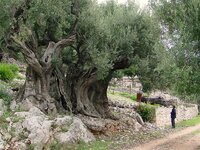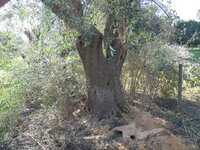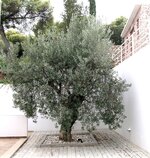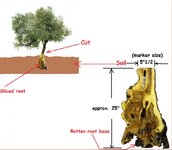Ok as promised......here's a pic of what i refuse to cut, lol! I added a sharpie for size reference. This was just a small piece that i was able to get along with some actual root pieces that i already cut up. Towards the left of the picture is the part that would be in the ground. In fact if you look at the lower left hand corner you will see a really thick root that was uncut.
I really enjoy the beauty of wood, but i would very much rather see a tree alive than cut down. This tree was heavy impacted by termites. Which would explain how/why it got sick and died.
Thanks for looking!
Pitoon
Now, that's something...!

:wink:
A little surprised with the colour on very bottom of the root, there is a grey there that don't belong (sort of thing), and while most people say that, "you can't kill an Olive tree...!" I can that, yes they can be extremely difficult to kill however, there is one mix (liquids) that will kill an Olive tree in 3 months max. guaranteed. Off-course, I'm not going to divulge/say/share what that mix is for more than legal reasons so, don't ask...!

I have probably seen every possible place where a Olive tree can grow, including places where they grows extremely slow (pour soils) and places where they strive, producing more wood (sapwood) than they should, compromising considerably the fruit quality/acidity.
This mean that, there are situations where a Olive tree is all of a certain surrounded with elements that are adverse to its development and in many times, survival. I recall you saying that, this tree was about 250 years old and that it died. Well, they just don't die at such age but natural means, there had to be some negative human intervention at some point.
One way to possibly kill an Olive tree is to enclose all the soil around it with cement/pavings, etc., leaving only a small opening at the tree butt, this attached pic show well what I mean.
View attachment 108395
I have put together a picture where I used the sliced root provided on this thread to put things in perspective to what I believe, the tree would look.
View attachment 108396
I have some difficulty in believe that, this tree could be that old, based on the pic of the slice shown, which was pretty much sliced to produce the approx. 2" thickness at the roots centre, the black marker seem to indicated the position of the tree separation from the root, I use those exact same markers and they are 5"1/2 long, which matches pretty much the diameter of the root "neck", root/butt joint.
While I never seen a tree of such age developing such a narrow and uniform "neck", that is something that I would expect from a tree about 20 to 40 years old, depending on the location where it was growing HOWEVER, and that is the most intriguing aspect, the grain and heartwood size shown, it takes a very long time to develop, at least 80 years so, it doesn't make much sense to me, and something isn't right...!:frown:

And this is where Pitton, you could probably help me out a bit and give some more info about this tree that you seem to know its origin.
As I indicate on the pic above, what killed that Olive tree in my view, was "rot" on the very bottom/base of the root system, which we normally call the "feeder roots". What cause that rot, you may be able to find out by talking to the people that had that tree and find out, if there was a damaged septic tank or a liquids disposable hole, close to this tree.
Too much "richness" as nutrients, can either trigger trees to grow 3 times as fast or, burn their roots and kill them. It seems to me that, this tree has had some human development happening these last 10 to 20 years of the tree's life, something very strong has reached the tree feeders and burnt them, stopping nutrients to pass through and unable the tree to feed at all.
This process can be a quite slow one, particularly with Olive trees, its their natural oils preserved within the tree that allows the wood from drying from the inside out, maintaining the wood fibers/cells alive for some time, before the leafs brown out and fall.
The one thing that I don't like about what the natural oils can do in the Olive roots, particularly if they have some rot is that, they absolutely "stink to hell", when disturbed/cut and for some time afterwards (many months..!

).
The other side on all this is that, those "rotten" spots normally produce the best colours and grains you will ever see...!:wink::biggrin:
Now, is no news for those that know me that, I have a passion for woods/trees and Olive wood/trees, rates the highest position of the lot.
Everything I said/done here, is in the context of education and additional information about the subject of this thread. No one has asked me to do so, and I hope you guys see it for what it is, simply sharing my knowledge and experience on the subject is question, completely and totally free of charge.
Anyone that likes to learn new things or appreciate getting relevant information, will find what I said interesting and puzzling, I don't have all the answers but I certainly continue to ask questions.
For anyone that, has an interest in Olive trees or for those that don't really know much about them, I would suggest strongly to have a good look at the web link I will provide, next. You will see what nature and age can do with Olive trees, its sizes, shapes and locations are nothing less than mesmerizing, really works of art.
On this same page, you can keep downloading more , when you reach the bottom of the page, you will also see images of people/locals in distress as a result of their loss (olive trees), the information is provided from people on site and from the country(ies) where these things still happening today, ands as we speak. You may find all the evidence you need to validate my claims about the sustainability and availability of this resource to the world, you see for yourself...!
 https://www.google.com.au/search?q=...&sqi=2&ved=0CCYQsAQ&biw=1536&bih=757#imgdii=_
https://www.google.com.au/search?q=...&sqi=2&ved=0CCYQsAQ&biw=1536&bih=757#imgdii=_
Have fun,
Cheers
George












